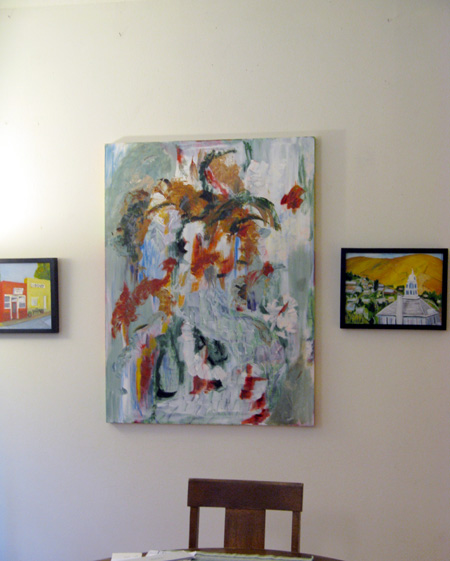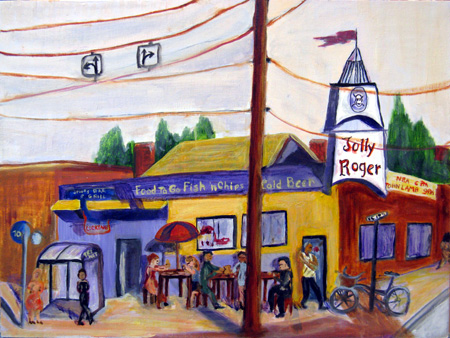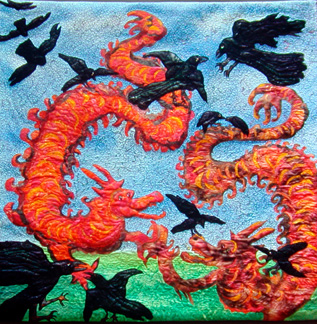Across from my normal sitting place in our dining room (which is really our living/kitchen/common room) are some paintings –Frippery, 36 x 40″ oil on canvas, Condon Library (far left), and Heppner Courthouse, both 12 x 16 inches, oil on board.
Posts by June Underwood
Corners of the City — Some text about some painting
The Jolly Roger Bar, 12th and Madison. Oil on board, 12 x 16″
As you know, I’ve been painting around Portland, here and there, returning often to sites to note what else is there, what I may have missed, what more is available for turning into paint.
These paintings have a certain “feel” to them — a style that fits with the record of my visits. I work on-site and then tweak and fiddle in the studio. I also find myself making larger, stranger, studio-begot contributions to the sets of pieces.
Rain and Sun: more on edges
I am continuing to re- and re-read Schmid’s chapter on edges, because I’m not sure I have a decently full grasp of what he’s saying.
The book is Alla Prima: Everything I Know About Painting by Richard Schmid ($50 USD in soft cover from him; more from Amazon and more in hard cover).
Schmid begins his chapter by saying “Think about edges the way you would think about kissing someone…. Think of edges as exquisite subtleties, as the means to transmit romance, as ways to make your dabs or paint whisper or shout and reach nuances beyond the range of color. Think of them as visual poetry… but especially think of edges as you would the agents of expression in music….pianissimo (very soft), andante (flowing), allegro vivace (fast and lively), maestoso (majestic), fortissimo con sforzando (whamo!).
Edges and a trash can
[Note: This post also appears on my personal blog, southeast main. Jay has persuaded me to cross-post as an efficiency matter. I find it changes my thinking to do it this way, which is a different, but also interesting, topic. Hi all — I’m glad to be back.]
I’m thinking about edges. I have a theory — or rather a “notion,” (which is a theory that is so diffuse it has no edges) — but anyway…..
My theory is that a lot of textile art maintains its textilishness via its edges. And this is in spite of the hand-dyed fabrics, surface design with fuzzy results, sheer fabrics, and other fuzzying techniques of contemporary textile artists. The edges of quilted art are often delineated by the quilting ; sometimes they are even more clearly portrayed with zigzag applique. Applique by itself lends itself to clean edges, as do commercial fabrics. Piecing fabric together gives a seam line, which makes an edge, even when the fabrics are close in color and value.
The clarity of edges in textiles tends to pull the textile toward something I think of as “good design” such as can be seen in magazine ads and hard-edged abstract art. This clarity has a certain appeal –it’s clean, not mushy, not sentimental. Clarity has a sureness of feel about it (which is probably why it’s so popular in advertisements). It’s also good for a certain kind of whimsicality, of child-like sensibility. The “faux representational” look in textile art often derives from its clear, often hard, edges.
Arabesque, 40″ x 40″, hand-dyed cottons and silk hanks, appliqued and machine quilted
Art as Surround (or what I saw in Seattle)
We are back from a few days visit to Seattle, a city overwhelming in its presence at this time of year. We were there at the height of the tourist season, staying near the Pike Street Market, in the very trendy, Belltown area. The scene was the art. Installation art at its best.
Some samples: a couple of buskers played what I think of as Appalachian, semi-bluegrass music. The young woman drummed and danced on her sound board, their voices had that mountain tension and piercing quality that carried through the roar of traffic and crowds of people, and beside them danced a dad and daughter, clearing a little space of their own to feel their own bodies. I danced a bit too.
There was also the accordionist at the Italian restaurant where we ate outside. He looked like a classic street musician, with a thick mustache, a tweed hat, and a big smile. We ate outside, a rare occasion because the evenings in the Pacific Northwest tend to be chilly and uncomfortable. But this was just right, with the light Italian music filling the air.
The next day we strolled through the new Seattle Art Museum Sculpture Garden located on the waterfront, in an ingenious zigzag across railroad tracks and freeways. We stopped to watch busking gymnasts go through their gyrations. They used the Alexander Calder Eagle as their stage, and we could see them as well as more parents and children (who did their own tumbling act) with the backdrop of sunny Puget Sound, filled with sails and tankers and ferries.
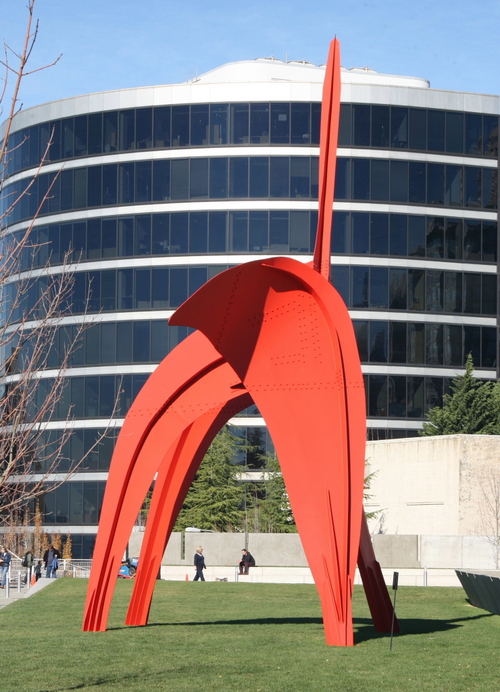
Then we went inside the pavilion to chuckle over the giant bulletin board of artist Goeff McFetridge:
The best moment was when a kid told her Mom: “Look at that guy upside down on his chair. I can do that, I can do that!”
The morning before we took the train home, we spent a couple of hours at the newly renovated downtown Seattle Art Museum building. The Impressionist exhibit had a too-long line so we wandered through galleries featuring varied permanent artworks. I studied painting techniques, and Jer observed absurdities. But when we reached the 4th floor, we were stunned by the African Art installation exhibit. (This exhibit isn’t clearly documented on SAM’s website but some understanding of it can be reached by reading the statements from a 2002 exhibit Long Steps Never Broke a Back. The audio/video pieces seen within the individual contemporary artist’s shown on SAM’s website gives some feel for what part of this 2008 exhibit consisted of.) Some of the art is part of SAM’s permanent collection, and some is a special exhibit of work by Willliam Kentridge, a South African video/performance artist. The presentation is stunning, making for a stunning surround for the “spectator.”
There are the usual masks and artifacts, presented on pedestals and behind glass. There are ancient masks and headresses. And, there are mannequins, dressed, life-sized and placed through-out the area — dancers and enactors of indigenous rituals, rituals which make use of body painting as well as masks and capes of feathers, etc. The mannequins reveal a lot beyond the art as it was presented cool and calm on its pedestals.
African Yoruba Nigerian Arobatan
Gelede Mask: Equestrian, 1920-1940
Wood and pigment
25 x 13 x 14 1/2 in. (63.5 x 33 x 36.8 cm)
African Ejagham Nigerian Cameroon
Basinjom mask and gown,
Cloth, wood, feathers, porcupine quills, mirrors, herbs, raffia, cowrie shells, rattle, eggshell, knife, and genet cat skin
34 1/4 x 17 11/16 x 19 11/16 in. (87 x 45 x 50 cm)
Mende Sande Society Sierra Leonean
Sowei mask, 20th century
Wood, raffia, yarn, leather, duct tape, and fabric
Overall h., irregular: 34 in.
And above these life-sized dressed figures are a couple of large video screens, which project African dancing and other ritual actions with the participants in full regalia; the videos are dated 1992 and there are spectators in ordinary western dress mingling with the creatures seemingly from another world. These videos, along with the sounds of the drumming and of the participants, surrounded us as we moved from the open area where the mannequins are placed.
Down a hallway, traditionally presented African art, encapsulated within its protective devices, is across from an opaque glass half-wall ( a 3-foot wall topping the escalator shaft) onto which other colorful videos of similar ritual activiities are projected. These videos showed artifacts similar to those presented conventionally, and thus the actual artifacts feel far more impressive and real than they seem displayed as separate “precious” art works. Finally, on the far side of the escalators away from the spectators, but on the wall above the shaft, facing the pedestaled art, is a video by artist William Kentridge. The video is part of Shadow Procession, a fantastic set of black silhouetted figures against a white backdrop, led by a trickster monster, Ubu. The initial part of the video has the monster setting up the scene, which is highly fantastic. However, as the “shadow procession” proceeds, the fantastic gives way to the horrifying, showing slaves, chained together, with all the accompanying horrors that could be imagined through silhouettes. It is a bit as if Kara Walker’s silhouettes moved into action.
So across the escalators we could see the black and white projected video of slave gangs as well as on the closer wall at our waists on which is projected the colorful dancing rituals of a contemporary African group in full regalia. On the other side of our aisle is the traditional museum exhibit of precious African objects behind glass and on pedestals.
And then we saw that, because we walked between the projectors and the wall projections, our shadows became part of the shadows on the walls; we were not just observers, we were observed and participants.
Dancing beside the buskers, treading the grass under a Caldecott artifact, observing a child enthralled with an art exhibit, being surrounded by ancient and contemporary artifacts from cultures whose descendants surround us — well, as I announced, surrounded by and enthralled also, by art.
In Retrospect
I’m back from the road trip, muddling about until my body decides it’s home.
Muddling about includes mulling over ideas, thoughts, notions, and niggles that life has handed me. Here’s a set of thoughts that I’ve maundered through in the last few days.
People, making conversation with the plein air worker, often ask “How long have you been painting?” My stock answer is “Oh, about 5 years.”
But I was cleaning up some old piles of stuff today, and ran across a whole covey of watercolors and acrylics that were dated 1999. Now my math is bad, but not that bad. Somehow time, or memory, had gotten short-circuited. I remember the class now; it was “painting the figure in watercolor,” and I stumbled into it by mistake, much, I suspect, to the horror of the very nice instructor.

Rosie, Winter, 1999, watercolor, 15 x 22″
Painting Expedition and Road Trip
I’m on the road with Jer, working on painting scenes from many tiny hamlets in the high desert of eastern Oregon. We started on Monday, it is now Thursday, and I have eight 12 x 16″ plein air oil paintings in my boxes in the back of the Honda. I also have a peeling nose (in spite of all precautions against the sun) and a whole set of images, some photos, some memories, of Oregon’s outback.The paintings are too raw to be shown right now, but here are some photos of things I painted:
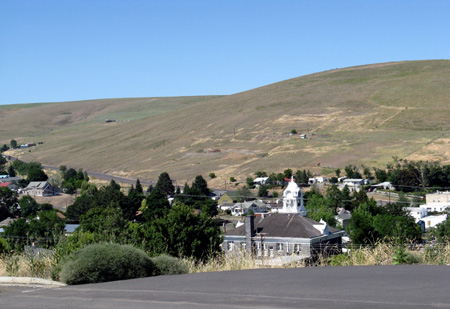
The Heppner, Oregon, courthouse and uplands
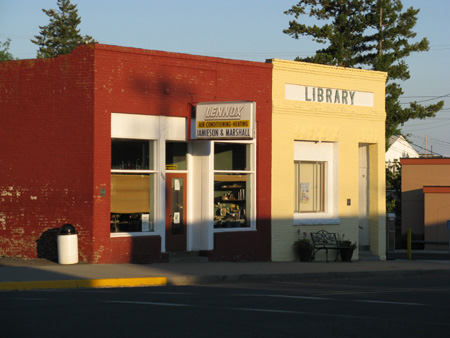
The Condon Library and Lennox Heating and Cooling Store (circa 1903, erstwhile bank and saloon)
